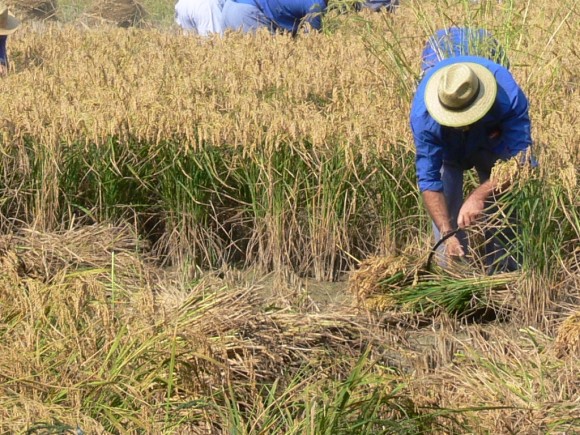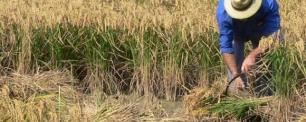Catalonia's agricultural soils contain four years' worth of carbon emissions
The soils below dryland crops contain 54% of Catalan agricultural land's 48 million tons of organic carbon, although the highest concentrations are found in rice fields and pastures.

A map of the organic carbon stocks in Catalonia's agricultural soils was presented at the headquarters of the Institute for Catalan Studies (IEC) in Barcelona on 7 June, with the support of the IEC's Catalan Institution for Agricultural Studies (ICEA). In the words of CREAF researcher Jordi Vayreda, the map will show “changes in soil carbon capacity, the importance of our agricultural soils' role in mitigating climate change, and the most suitable cultivation techniques”. Catalan agricultural soils (we refer, throughout this article, to the top 30 cm of such soils) contain an average of 4.9 kg C/m2 (kg of organic carbon per square metre). On that basis, Catalonia's 9,830 km2 of agricultural land have total organic carbon stocks of almost 48 million tons, equivalent to four years' worth of the entire territory's carbon dioxide (CO2) emissions, according to the 2015 inventory of greenhouse gas emissions in Catalonia. “That's a very significant figure, bearing in mind that it corresponds to 33% of Catalonia's surface area and contributes to the mitigating role COP 21 and COP 22 attributed to agriculture”, points out Institute of Agrifood Research and Technology (IRTA) researcher Robert Savé.
Arable land, which is mainly used for growing dryland crops such as cereals, is the most common type of agricultural land in Catalonia and accounts for the largest proportion of its organic carbon (53.9%). However, it is in rice fields —totalling just 200 km2, all situated in the Ebro Delta and Empordà regions— and pastures —of which there are 340 km2 throughout Catalonia— that the highest concentrations of organic carbon per m2 are found.
Les terres arables, sobretot dedicades a conreus de secà com els cereals, són les més extenses i les que acumulen per tant més carboni orgànic total (un 53,9%). En canvi, els arrossars —els quals ocupen només 200 km2 concentrats al delta de l’Ebre i l’Empordà— i les pastures en ús pels ramats —amb una extensió de 340 km2 a tot Catalunya— són els que més carboni orgànic retenen per m2.
The research behind the map complements a CREAF-led study that calculated the organic carbon stocks in Spain's forest soils and found Catalonia's mean value, to a depth of 1 m, to be 8.8 kg C/m2.
Crop type determines soil carbon capacity
Most of Catalonia's agricultural land lies on Lleida's plain, where carbon stocks are moderate (between 4 and 5.5 kg C/m2). The highest stock levels (over 6 kg C/m2) are in the north, where there are pastures, and in the Ebro Delta region, with its rice fields. The lowest (under 4 kg C/m2) are in the central pre-coastal area, which is home to many of the territory's grapevines and olive trees. “The low values of vineyards and olive groves are due to soil properties, specifically stoniness, components and texture, as well as to crop type, farming methods, and the use made of the land over centuries”, says Josep Maria Alcañiz, CREAF researcher and professor of edaphology and agricultural chemistry at the Autonomous University of Barcelona.

In Catalonia, 54.3% of crop fields are classed as arable land, which is mainly used for growing cereals. It is the soils of such land that contain the greatest overall quantity of organic carbon (25.8 million tons, 53.9% of the total), followed by orchard soils (7 million tons, 14.7%) and olive grove soils (5.8 million tons, 15.1% of the total).
Nonetheless, the soils beneath rice fields are the most efficient when it comes to storing organic carbon. Rice fields account for only 2% of Catalonia's agricultural land (200 km2) but contain 3% of its organic carbon (1.4 million tons), meaning that their soils accumulate 6.49 kg C/m2, well above average. Pasture soils are the second most efficient, with a content of 6.36 kg C/m2. Pastures thus hold 4.9% (2.3 million tons) of Catalan agricultural land's organic carbon, despite making up only 3.5% (340 km2) of it. Vineyard soils are the least efficient, with a content of 3.9 kg C/m2. Vineyards represent 5.7% (560 km2) of Catalan agricultural land but their soils contain just 4.1% (2 million tons) of its organic carbon
The map is the fruit of cooperation between CREAF and the Cartographic and Geological Institute of Catalonia (ICGC), the Government of Catalonia's Ministry of Agriculture, Livestock Farming, Fishing and Food (DARP), the IRTA and the Forest Science and Technology Centre of Catalonia (CTFC). At a scale of 1:500,000 and with a resolution of 180 million pixels, it is based on descriptions and analyses of 7,000 agricultural soil profiles corresponding to samples taken across Catalonia between 1980 and 2015, with agricultural (dryland or irrigated crops), climatic (annual precipitation and evapotranspiration) and topographic (altitude) variables factored in.
No obstant, són els sòls dels camps d’arròs els més eficients a l’hora d’emmagatzemar carboni orgànic. Els arrossars només ocupen el 2% del terreny agrícola català (200 km2), però contenen el 3% del total de carboni orgànic (1,4 milions de tones). Això suposa que aquests sòls acumulin uns 6,49 kg C/m2, força per sobre la mitjana. Les pastures també són més eficients que la resta de sòls, ja que emmagatzemen uns 6,36 kg C/m2. Així que, tot i ocupar només el 3,5% del territori agrícola (340 km2), acumulen el 4,9% del carboni orgànic (2,3 milions de tones). En canvi, els sòls amb vinya són els més pobres en carboni, amb 3,9 kg C/m2. El conreu de la vinya ocupa el 5,7% de la superfície agrícola (560 km2), però els seus sòls només contenen el 4,1% del carboni orgànic (2 milions de tones).
Soil organic carbon improves crop productivity and helps mitigate the effects of climate change
IRTA researcher Immaculada Funes presented the map at an event entitled ‘Organic carbon in agricultural soils: a tool for mitigating climate change in Catalonia’. Organic carbon is a result of bacteria, fungi and soil invertebrates decomposing organic matter from the remains of other living organisms, especially plants, which incorporate atmospheric CO2 into their structures through photosynthesis. “Crops, and plants in general, grow better in soils rich in organic carbon”, states Funes. “The carbon acts like a sponge, helping soil hold on to nutrients and water for plants”, she explains.
However, poor agricultural practices, including over-fertilization and excessively intensive farming, reduce soil's organic carbon capacity.
“Applying organic fertilizers can contribute to increasing agricultural soils' carbon content”, observes Alcañiz. “One option is to use biochar —carbon obtained from organic waste— which not only improves soil fertility but also represents an opportunity to recycle waste, to obtain energy and other products as part of a circular economy strategy”, he adds..
The ‘4 per 1000’ initiative
The event also featured an explanation of the benefits of the ‘4 per 1000’ strategy. Launched at COP21 in Paris in 2015, this initiative is aimed at increasing the organic carbon content of agricultural and forest soils throughout the world by 0.4% (or 4‰) each year. Doing so would enable soils to sequester enough organic carbon to compensate for the CO2 emitted into the atmosphere through human activities, help mitigate the effects of climate change and, owing to greater crop productivity, boost the food supply worldwide.






